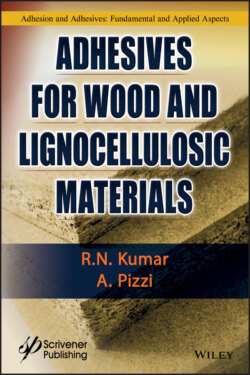Читать книгу Adhesives for Wood and Lignocellulosic Materials - R. N. Kumar - Страница 23
1.4.3 Lignin
ОглавлениеLignin is a heterogeneous three-dimensional polymer that constitutes approximately 30% of the dry weight of wood. Lignin limits the penetration of water into the wood cells and makes wood very compact.
Lignin is the second most abundant and important organic substance in the plant world. Lignin increases the mechanical strength and stiffness properties to such an extent that huge plants such as trees with heights of even more than 100 m can remain upright.
Lignin is a complex polymer of phenylpropane units (monolignols) joined through many different linkages. The three monolignols are p-coumaryl alcohol, coniferyl alcohol, and sinapyl alcohol (Figure 1.4). The monolignols in various proportions are the building blocks for the 3-D structure of native lignin in higher plants [19]. Monolignols copolymerize mainly by radical polymerization.
Figure 1.4 The three monolignols.
Thus, the monolignols are the building blocks of the lignin macromolecule. Lignin is therefore defined as an amorphous polyphenolic material arising from an enzyme-mediated dehydrogenative polymerization (DHP) of three phenylpropanoid monomers, coniferyl, synapyl, and p-coumaryl alcohols.
The following nomenclature of radicals (Figure 1.5) and the building units from which lignin is derived should be kept in mind to understand scientific publications on lignin:
Figure 1.5 Radicals and units—nomenclature.
Lignin’s functions in the tree are as follows (Wang Wood Chemistry Class):
1 Support for mechanical strength
2 Antioxidant for protection
3 Sealant and reinforcing agents, bonding cellulose and hemicellulose together
4 Cross-linker to cross-link he polymeric carbohydrates
The so-called lignin–carbohydrates complex defines the type of covalent bonds existing between lignin and hemicelluloses. These are mainly benzyl ester and benzyl ether linkages between the side chains of xylans and phenyl glycosidic linkages with the main chain of glucomannans [11].
